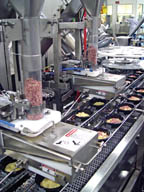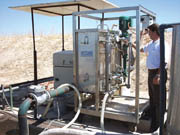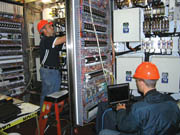
Walking down the aisles of a private-label manufacturers' trade show is a lot like touring a grocery manufacturers' exhibition: the same companies showcasing their branded products at one can be found at the other, hawking their manufacturing services. Typical of these companies is Malt-O-Meal Co., the nation's fourth largest cereal manufacturer. Besides Quaker cereals and its namesake brand, Malt-O-Meal spoons up private-label breakfasts for Kroger, Safeway and other retailers.
"Core competencies" is the easy answer to why food companies farm out some elements of production and not others, but today's market is more nuanced than that. For example, customer service can be the outsourcing driver. Pasta heavyweight American Italian Pasta Co. (AIPC) relies on comanufacturers to produce specialty items like the giant manicotti shells retail and foodservice customers want. One-stop convenience for clients trumps sending them elsewhere to round out their category needs.
For mainstream pasta, AIPC's pennies-per-pound cost structure is unsurpassed in North America. The company built its 500,000-lb. daily capacity Kenosha, WI, facility with comanufacturing in mind. Industrial accounts such as Kraft, General Mills and Luigino's Inc. (maker of Michelina's and Budget Gourmet frozen entrees) are served by Kenosha. But these companies rely on AIPC to varying degrees, and many other potential customers continue making their own. A case in point is Request Foods, a Holland, MI, copacker of frozen entrees. Request serves some of the biggest food brands in the world, and it prefers the vertical integration of on-site pasta production in its 350,000-sq.-ft. facility to outsourcing, regardless of the potential cost efficiencies.
With four facilities, AIPC could easily produce all the macaroni Kraft needs; instead, the cheese giant maintains two older pasta plants and relies on AIPC to meet back-to-school demand spikes for its macaroni & cheese, as well as newer shapes and formulations requiring advanced technology, such as Easy Mac microwavable single-serves. Labor contracts, decommissioning costs, public image and other factors weigh against Kraft closing its pasta plants and laying off hundreds of workers.
Collaboration squared
The July rollout of a new bar-mix line called Cocktail Chemistry dramatizes the complex web of relationships being forged between food companies, their customers and suppliers. El Paso Chile Co. created the mixers, Appletini, Cosmo and Lemon Drop, at the request of Target Corp. Margarita mixes and other bar mixes had already joined bean dips and other regional specialties in El Paso's product line, but Target buyers stipulated Cocktail Chemistry had to be packaged in plastic, not the glass containers El Paso favors.
El Paso's management had asked Chicago-based Berlin Packaging to source lower-cost glass bottles just two days before the Target project came up. The glass project was quickly scrapped, and Berlin's Cathy Damon was redirected to develop design ideas for the Target project. "It started morphing from a container with a packet of rimming salt into a three-piece package that doubles as a martini shaker," recalls Damon. The overcap functions as a jigger, and a dual-flap closure can be used as an ice strainer and a pour spout. Including tool makers, shrink-sleeve suppliers and others, Damon drew on eight third parties to create the packaging system. The bottles are being filled by yet another collaborator: Dallas-based Jus-Made LP.
The project illustrates how complex co-relationships are replacing simple buyer-supplier transactions. To move component manufacture from the drawing board to the production line, participants needed "a comfort level" that there would be a return on their investments, says Damon. "For every bottle, the equipment today is so specific," she says. "It could require a $5,000 machine part to implement on your rotary filler, but how does the manufacturer know if the order volumes are going to be enough to pay for that?" To bring exciting new food and beverage products to market, multi-party collaborations in which retailers have capital at risk may be necessary to achieve a comfort level, she suggests.
Imperial Sugar Co. found a way to hedge its bet on a new reclosable pouch for granulated sugar. Manufacturers started using pouches for high-margin products like powdered and brown sugar in the late 1990s, but granulated sugar had been relegated to paper bags. Before committing to more expensive packaging that would require a new line, Imperial wanted hard sales data. It was a pilot test tailor-made for a copacker, and in Imperial's case, the copacker also was the OEM for the packaging machinery.
Machine designer Bob Koppe founded Roberts Packaging Inc. in Battle Creek, MI, in 1972 to build cartoning machines. A year later, General Foods asked him to fill Tang in a pouch, and Roberts' copacking division was born. Dissatisfied with existing form/fill/seal machines for pouches, Koppe built his own units. Thirty-two years later, the synergies between machine building and commercial copacking are producing improvements for a line of continuous-motion, horizontal f/f/s machines, four of which run every day in Koppe's 120,000-sq.-ft., AIB-certified facility.
"Buying a machine that can form and fill 120 zippered bags a minute represents a substantial capital investment for us, and it's risky to introduce something new, especially for a tight-margin product," points out Art Saxby, vice president of marketing at Imperial Sugar. "There's value in packaging, there's value in convenience." The question is, are enough people willing to pay for convenience to offset the manufacturer's capital cost? Last summer, the company commissioned Roberts to fill its sugar in 3.4-lb. gusseted pouches for a test in 30 Texas supermarkets. The downsized package-the company's granulated sugar typically is sold in 4- or 5-lb. bags-is priced the same as the larger packages to offset the higher cost of the packaging material.
Cloud Packaging pioneered the machine building/contract packaging model in 1959, when Morton Salt asked the Des Plaines, IL, firm to fill portion packs. The long-term relationship elevated Cloud's OEM skills, and today's Cloud machines fill single-serving sweetener packets at rates exceeding 2,400 units a minute. "It's not the easiest strategy to execute because engineering and processing are completely different skill sets," says Kevin Fritzmeyer, president of parent company, Cloud Packaging Solutions, St. Louis. Nonetheless, the segue into copacking transformed the firm. Today, copacking constitutes two-thirds of Cloud's business.
Copacking also lifted Roberts' machine-building game, Koppe adds. "We're constantly learning what works and what doesn't," he says. "It's like having the biggest R&D center ever. Every machinery manufacturer I talk to thinks this is a great idea, but nobody does it except us and Cloud."
BOO who
If pasta-making and cocktail-filling are outside a growing number of food and beverage companies' core competencies, imagine the potential for waste treatment. Pretreatment of wastewater is emerging as a critical need for processors, and while installing a treatment system is one thing, operating it is quite another. Turnkey management of these systems is a natural fit, and at least one firm is ready to provide it."It's a service mentality," says Michael Everton, a founder of Acqua America Inc., Tampa, FL. "We want to build, own and operate waste treatment systems for large farms and food processors. A BOO system, we call it."

Remote monitoring equipment, possibly including a video feed, is sufficient for technicians to manage the treatment system from any location in the world via modem, Everton says. The company already manages recovery systems at 50 Australian industrial and retail locations, including McDonald's restaurants. A service technician visits each site on a quarterly basis, barring any system malfunctions requiring hands-on servicing.
Remote monitoring also is part of the package at BPI Technology Inc., the machine-building arm of Beef Processors Inc., Dakota Dunes, SD. But BPI's real-time monitoring cuts to the heart of client operations. The equipment is massive: BPI's grinding, blending and pumping units are 140 tons of stainless steel and arrive at meat plants on six flatbed trailers. Less imposing but equally impressive is the controls architecture. The pumping/grinding elements have 800 I/O points, according to Erlan Rice, BPI's director of electrical engineering. "It's highly specialized equipment that the industry hasn't seen before," he says, "and the 24/7 live monitoring of machine state that we provide is something most facilities are not equipped to do themselves. We're sort of like OnStar, except we call you."

"We anticipated a lot of pushback to an operating system that could be viewed as a Big Brother approach," Rice allows, "but once processors see it in operation, they think it's the greatest thing since sliced bread." Users have reported increased uptime from forming equipment downstream from the blenders. The controls even provide a degree of predictive maintenance.
Outsourced controls management is in its infancy, but like other manufacturing and packaging services, it is growing. Many of the newest food and beverage companies are actually sales and marketing organizations that outsource all aspects of production. "We've seen a pick up in copacking in the last few years from companies that invent products and may never buy a machine from us," says Roberts' Koppe. "Even the big guys are doing more and more manufacturing and copacking outside their facilities. They run out of brick and mortar, and rather than build new facilities, they outsource to companies like us." Apparently, marketing is more fun than manufacturing: though no slouch at processing, Frito-Lay outsources $2.5 billion worth of its annual production.
That's not necessarily a bad thing. Rather than being a commodity business, manufacturing is evolving into a high-skill service. "It's not just lowest price anymore," says Cloud's Fritzmeyer. Instead of competing on price, processors who can deliver exceptional quality are finding a ready market for their services. And instead of doing many things adequately, food companies are focusing on doing a few things extremely well and collaborating with other firms with complementary skills.
For more information:
Michael Everton, Acqua America Inc.,
813-902-9030,
michael_everton@acquagroup.com
Cathy Damon, Berlin Packaging,
214-738-6946,
< a href="mailto:cdamon@berlinpackaging.com">cdamon@berlinpackaging.com
Mike Cunningham, BPI Technology Inc.,
712-899-6044,
mcunningham@beefproducts.com
Bob Koppe, Roberts Packaging,
269-962-5525